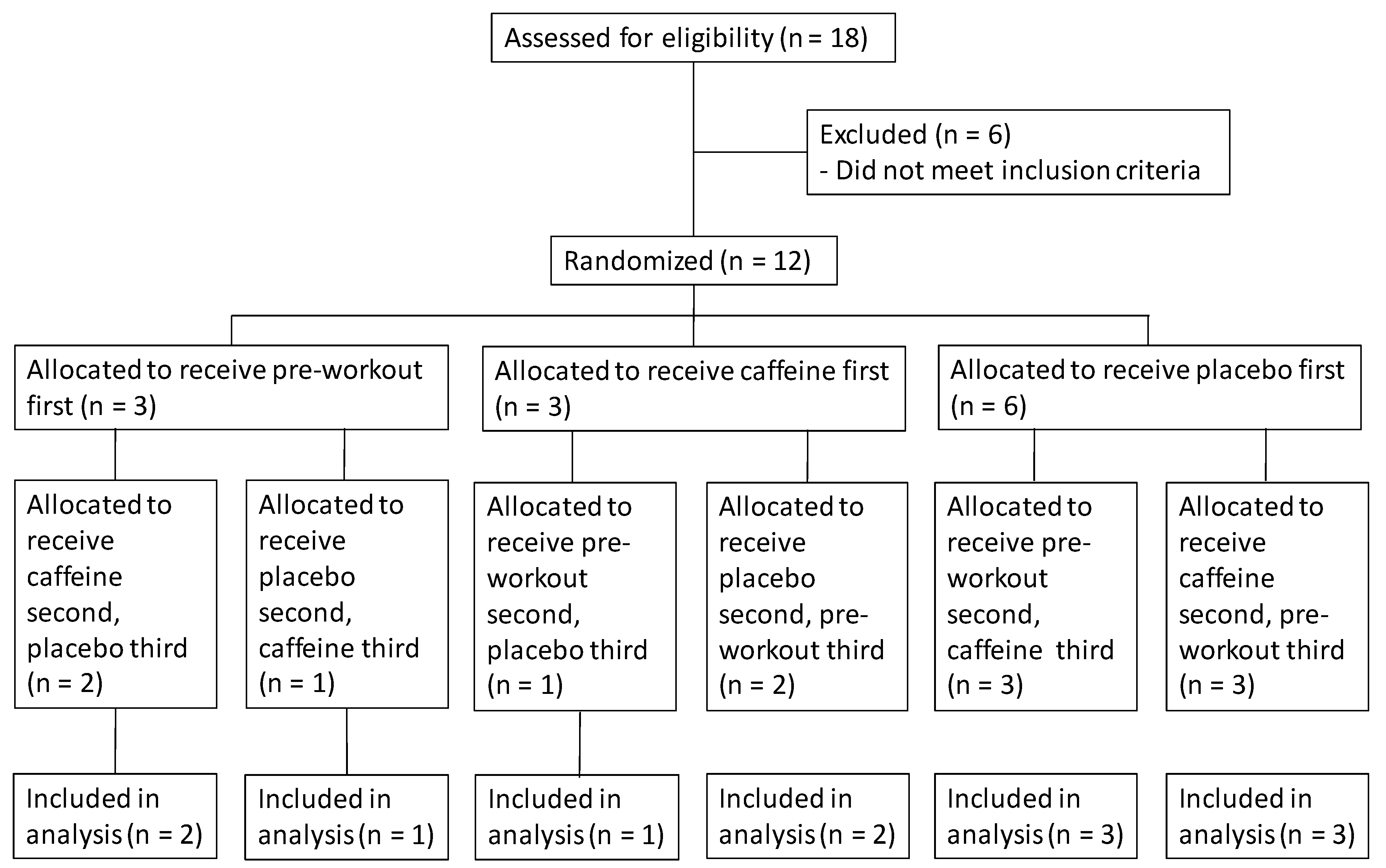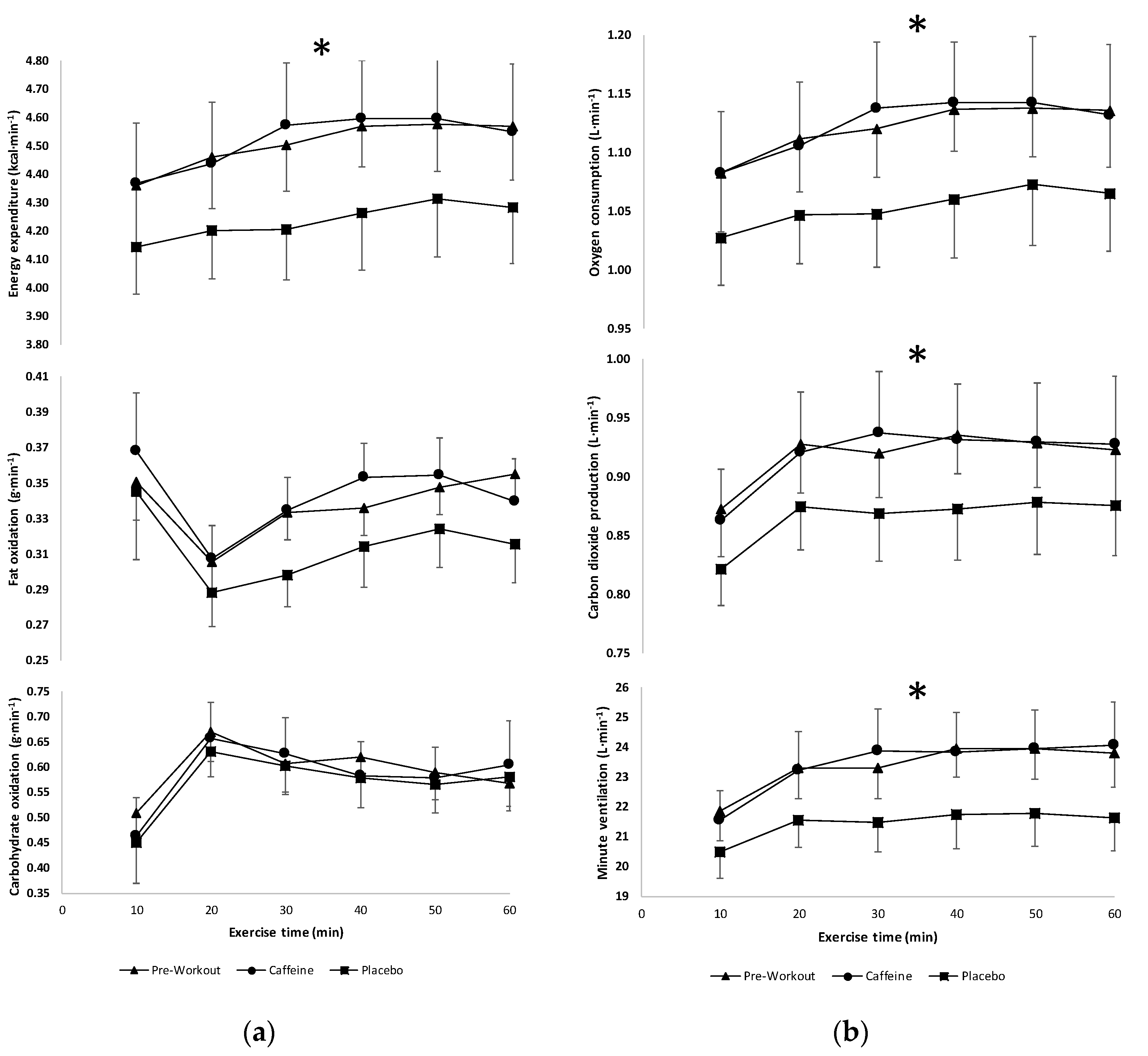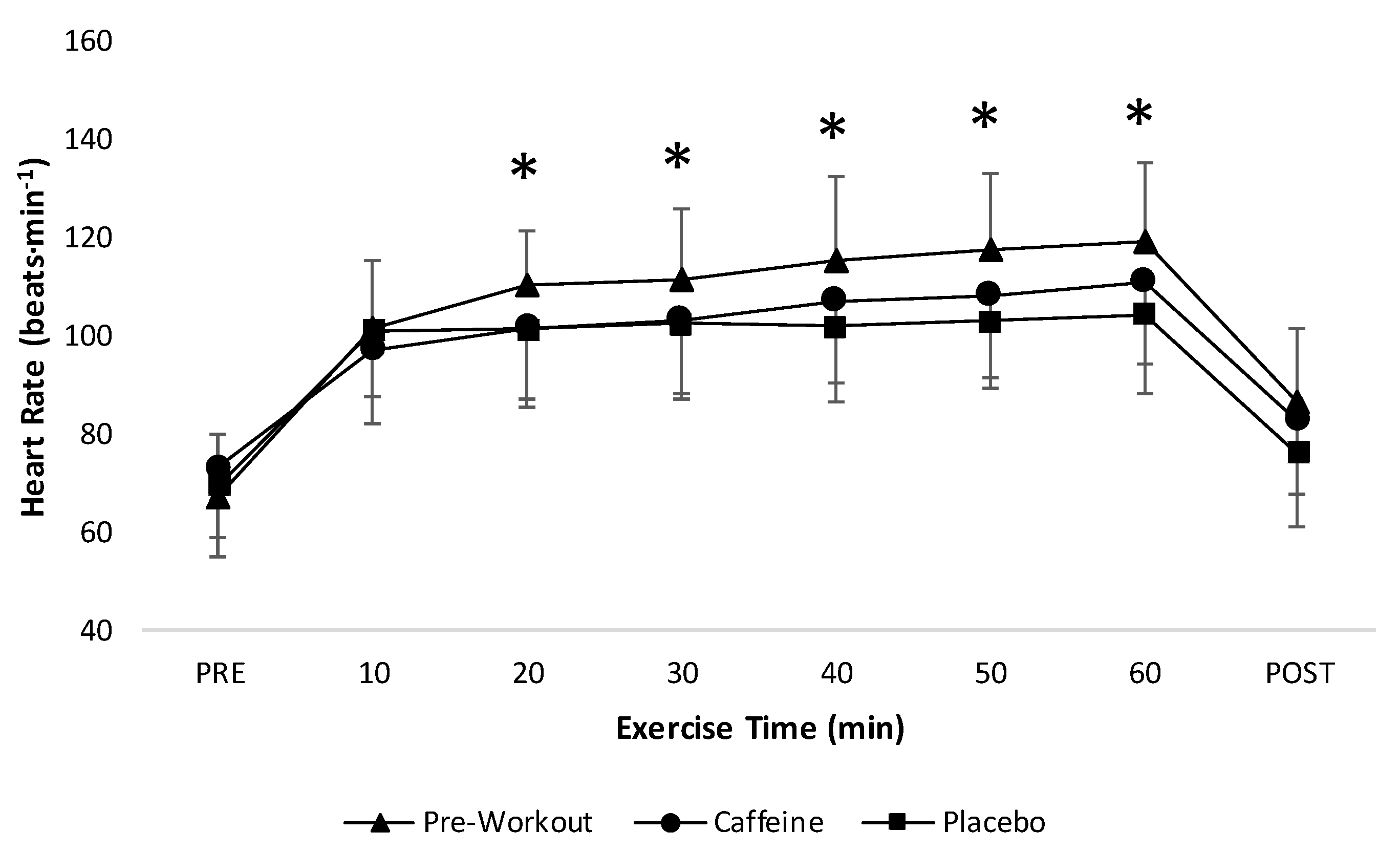Effects of a Multi-Ingredient Preworkout Supplement Versus Caffeine on Energy Expenditure and Feelings of Fatigue during Low-Intensity Treadmill Exercise in College-Aged Males
Abstract
1. Introduction
2. Materials and Methods
2.1. Study Design
2.2. Subjects
2.2.1. Visit 1: Familiarization
2.2.2. Visit 2–4: Exercise Tests with Supplementation
Supplementation Protocol
Treadmill Exercise Tests
Estimation of Energy Expenditure and Substrate Utilization
Likert Scale and Questionnaire
Food Logs
Statistical Analyses
3. Results
3.1. Macronutrient Data
3.2. Metabolic Data
3.3. Subjective Measures of Fatigue and Exertion
3.3.1. Baseline
3.3.2. 30-Min Postingestion
3.3.3. Exercise
3.4. Heart Rate and Blood Pressure
4. Discussion
5. Conclusions
Author Contributions
Funding
Conflicts of Interest
References
- Jagim, A.R.; Camic, C.L.; Harty, P.S. Common habits, adverse events, and opinions regarding pre-workout supplement use among regular consumers. Nutrients 2019, 11, 855. [Google Scholar] [CrossRef] [PubMed]
- Jagim, A.R.; Harty, P.S.; Camic, C.L. Common ingredient profiles of multi-ingredient pre-workout supplements. Nutrients 2019, 11, 254. [Google Scholar] [CrossRef] [PubMed]
- Benowitz, N.L. Clinical pharmacology of caffeine. Annu. Rev. Med. 1990, 41, 277–288. [Google Scholar] [CrossRef] [PubMed]
- Aguilar-Navarro, M.; Munoz, G.; Salinero, J.J.; Munoz-Guerra, J.; Fernandez-Alvarez, M.; Del Mar Plata, M.; Del Coso, J. Urine caffeine concentration in doping control samples from 2004 to 2015. Nutrients. 2019, 11, 286. [Google Scholar] [CrossRef] [PubMed]
- Salinero, J.J.; Lara, B.; Del Coso, J. Effects of acute ingestion of caffeine on team sports performance: A systematic review and meta-analysis. Res. Sports Med. 2019, 27, 238–256. [Google Scholar] [CrossRef] [PubMed]
- Essig, D.; Costill, D.L.; Van Handel, P.J. Effects of caffeine ingestion on utilization of muscle glycogen and lipid during leg ergometer cycling. Int. J. Sports Med. 1980, 1, 86–90. [Google Scholar] [CrossRef]
- Ahrens, J.N.; Crixell, S.H.; Lloyd, L.K.; Walker, J.L. The physiological effects of caffeine in women during treadmill walking. J. Strength Cond. Res. 2007, 21, 164–168. [Google Scholar] [CrossRef]
- Wallman, K.E.; Goh, J.W.; Guelfi, K.J. Effects of caffeine on exercise performance in sedentary females. J. Sport Sci. Med. 2010, 9, 183–189. [Google Scholar]
- Lieberman, H.R.; Tharion, W.J.; Shukitt-Hale, B.; Speckman, K.L.; Tulley, R. Effects of caffeine, sleep loss, and stress on cognitive performance and mood during US Navy SEAL training. Psychopharmacology 2002, 164, 250–261. [Google Scholar] [CrossRef]
- Spriet, L.L. Caffeine and performance. Inter. J. Sport. Nutr. Exer. Metabo. 1995, 5, 84–99. [Google Scholar] [CrossRef]
- Demura, S.; Yamada, T.; Terasawa, N. Effect of coffee ingestion on physiological responses and ratings of perceived exertion during submaximal endurance exercise. Percept. Mot. Skills 2007, 105, 1109–1116. [Google Scholar] [CrossRef] [PubMed]
- Hogervorst, E.E.; Bandelow, S.; Schmitt, J.; Jentjens, R.O.; Oliveira, M.; Allgrove, J.; Carter, T.; Gleeson, M. Caffeine improves physical and cognitive performance during exhaustive exercise. Med. Sci. Sports. Exer. 2008, 40, 1841–1851. [Google Scholar] [CrossRef] [PubMed]
- Duncan, M.J.; Dobell, A.P.; Caygill, C.L.; Eyre, E.; Tallis, J. The effect of acute caffeine ingestion on upper body anaerobic exercise and cognitive performance. Eur. J. Sport Sci. 2019, 19, 103–111. [Google Scholar] [CrossRef] [PubMed]
- Poli, R.A.; Miyagi, W.E.; Nakamura, F.Y.; Zagatto, A.M. Caffeine Improved Time to Exhaustion But Did Not Change Alternative Maximal Accumulated Oxygen Deficit Estimated During a Single Supramaximal Running Bout. Int. J. Sport. Nutr. Exerc. Metab. 2016, 26, 549–557. [Google Scholar] [CrossRef]
- Kalmar, J.M.; Cafarelli, E. Effects of caffeine on neuromuscular function. J. App. Physio. 1999, 87, 801–808. [Google Scholar] [CrossRef]
- Woolf, K.; Bidwell, W.K.; Carlson, A.G. The effect of caffeine as an ergogenic aid in anaerobic exercise. Int. J. Sport. Nutr. Exer. Metabo. 2008, 18, 412–429. [Google Scholar] [CrossRef]
- Walsh, A.L.; Gonzalez, A.M.; Ratamess, N.A.; Kang, J.; Hoffman, J.R. Improved time to exhaustion following ingestion of the energy drink Amino Impact™. J. Inter. Soc. Sports. Nutr. 2010, 7, 14. [Google Scholar] [CrossRef]
- Bergstrom, H.C.; Byrd, M.T.; Wallace, B.J.; Clasey, J.L. Examination of a multi-ingredient preworkout supplement on total volume of resistance exercise and subsequent strength and power performance. J. Strength Cond. Res. 2018, 32, 1479–1490. [Google Scholar] [CrossRef]
- Collins, P.B.; Earnest, C.P.; Dalton, R.L.; Sowinski, R.J.; Grubic, T.J.; Favot, C.J.; Coletta, A.M.; Rasmussen, C.; Greenwood, M.; Kreider, R.B. Short-term effects of a ready-to-drink pre-workout beverage on exercise performance and recovery. Nutrients 2017, 9, 823. [Google Scholar] [CrossRef]
- Gonzalez, A.M.; Walsh, A.L.; Ratamess, N.A.; Kang, J.; Hoffman, J.R. Effect of a pre-workout energy supplement on acute multi-joint resistance exercise. J. Sports. Sci. Med. 2011, 10, 261. [Google Scholar]
- Jagim, A.R.; Jones, M.T.; Wright, G.A.; Antoine, C.S.; Kovacs, A.; Oliver, J.M. The acute effects of multi-ingredient pre-workout ingestion on strength performance, lower body power, and anaerobic capacity. J. Inter. Soc. Sports. Nutr. 2016, 13, 11. [Google Scholar] [CrossRef] [PubMed]
- Hoffman, J.R.; Ratamess, N.A.; Ross, R.; Shanklin, M.; Kang, J.; Faigenbaum, A.D. Effect of a pre-exercise energy supplement on the acute hormonal response to resistance exercise. J. Strength Cond. Res. 2008, 22, 874–882. [Google Scholar] [CrossRef] [PubMed]
- Cameron, M.; Camic, C.L.; Doberstein, S.; Erickson, J.L.; Jagim, A.R. The acute effects of a multi-ingredient preworkout supplement on resting energy expenditure and exercise performance in recreationally active females. J. Int. Soc. Sports Nutr. 2018, 15, 1. [Google Scholar] [CrossRef] [PubMed]
- Erickson, J.R.; Camic, C.L.; Jagim, A.R.; Pellersels, P.M.; Wright, G.A.; Henert, S.E.; Foster, C. Effects of One Versus Two Doses of a Multi-Ingredient Pre-Workout Supplement on Metabolic Factors and Perceived Exertion during Moderate-Intensity Running in Females. Sports 2020, 8, 52. [Google Scholar] [CrossRef]
- Jeukendrup, A.E.; Wallis, G.A. Measurement of substrate oxidation during exercise by means of gas exchange measurements. Int. J. Sports Med. 2005, 26 (Suppl. 1), 28–37. [Google Scholar] [CrossRef]
- Péronnet, F.; Massicotte, D. Table of nonprotein respiratory quotient: An update. Can. J. Sport Sci. 1991, 16, 23–29. [Google Scholar]
- Campbell, B.I.; Zito, G.; Colquhoun, R.; Martinez, N.; Kendall, K.; Buchanan, L.; Lehn, M.; Johnson, M.; Louis, C.S.; Smith, Y.; et al. The effects of a single-dose thermogenic supplement on resting metabolic rate and hemodynamic variables in healthy females-a randomized, double-blind, placebo-controlled, cross-over trial. J. Inter. Soc. Sports Nutr. 2016, 13, 13. [Google Scholar] [CrossRef]
- Jung, Y.P.; Earnest, C.P.; Koozehchian, M.; Galvan, E.; Dalton, R.; Walker, D.; Rasmussen, C.; Murano, P.S.; Greenwood, M.; Kreider, R.B. Effects of acute ingestion of a pre-workout dietary supplement with and without p-synephrine on resting energy expenditure, cognitive function and exercise performance. J. Inter. Soc. Sports Nutr. 2017, 14, 3. [Google Scholar] [CrossRef] [PubMed]
- Outlaw, J.; Wilborn, C.; Smith, A.; Urbina, S.; Hayward, S.; Foster, C.; Wells, S.; Wildman, R.; Taylor, L. Effects of ingestion of a commercially available thermogenic dietary supplement on resting energy expenditure, mood state and cardiovascular measures. J. Inter. Soc. Sports. Nutr. 2013, 10, 25. [Google Scholar] [CrossRef]
- Gutiérrez-Hellín, J.; Del Coso, J. Acute p-synephrine ingestion increases fat oxidation rate during exercise. Brit. J. Clin. Pharma. 2016, 82, 362–368. [Google Scholar] [CrossRef]
- Venables, M.C.; Hulston, C.J.; Cox, H.R.; Jeukendrup, A.E. Green tea extract ingestion, fat oxidation, and glucose tolerance in healthy humans. Amer. J. Clin. Nutr. 2008, 87, 778–784. [Google Scholar] [CrossRef]
- Hodgson, A.B.; Randell, R.K.; Jeukendrup, A.E. The effect of green tea extract on fat oxidation at rest and during exercise: Evidence of efficacy and proposed mechanisms. Adv. Nutr. 2013, 4, 129–140. [Google Scholar] [CrossRef] [PubMed]
- Dulloo, A.G.; Duret, C.; Rohrer, D.; Girardier, L.; Mensi, N.; Fathi, M.; Chantre, P.; Vandermander, J. Efficacy of a green tea extract rich in catechin polyphenols and caffeine in increasing 24-h energy expenditure and fat oxidation in humans. Amer. J. Clin. Nutr. 1999, 70, 1040–1045. [Google Scholar] [CrossRef] [PubMed]
- Roberts, J.D.; Roberts, M.G.; Tarpey, M.D.; Weekes, J.C.; Thomas, C.H. The effect of a decaffeinated green tea extract formula on fat oxidation, body composition and exercise performance. J. Inter. Soc. Sports Nutr. 2015, 12, 1. [Google Scholar] [CrossRef] [PubMed]
- Kawada, T.; Watanabe, T.; Takaishi, T.; Tanaka, T.; Iwai, K. Formation and metabolism of the pungent principle of capsicum fruits. 17. Capsaicin-induced beta-adreneric action on energy-metabolism in rats-influence of capsaicin on oxygen-consumption, the respiratory quotient, and substrate utilization. Pro. Soc. Exp. Bio. Med. 1986, 183, 250–256. [Google Scholar] [CrossRef]
- Josse, A.R.; Sherriffs, S.S.; Holwerda, A.M.; Andrews, R.; Staples, A.W.; Phillips, S.M. Effects of capsinoid ingestion on energy expenditure and lipid oxidation at rest and during exercise. Nutr. Metab. 2010, 7, 65. [Google Scholar] [CrossRef] [PubMed]
- Ohnuki, K.; Niwa, S.; Maeda, S.; Inoue, N.; Yazawa, S.; Fushiki, T. CH-19 sweet, a non-pungent cultivar of red pepper, increased body temperature and oxygen consumption in humans. Biosci. Biotech. Biochem. 2001, 65, 2033–2206. [Google Scholar] [CrossRef]
- Chen, P.; Bryden, N. Determination of yohimbine in yohimbe bark and related dietary supplements using UHPLC-UV/MS: Single-laboratory validation. J. AOAC Int. 2015, 98, 896–901. [Google Scholar] [CrossRef]
- Goldberg, M.R.; Robertson, D. Yohimbine: A pharmacological probe for study of the alpha 2-adrenoreceptor. Pharmacol. Rev. 1983, 35, 143–180. [Google Scholar]
- Hulston, C.J.; Jeukendrup, A.E. Substrate metabolism and exercise performance with caffeine and carbohydrate intake. Med. Sci. Sports Exer. 2008, 40, 2096–2104. [Google Scholar] [CrossRef]
- Hoffman, J.R.; Kang, J.; Ratamess, N.A.; Rashti, S.L.; Tranchina, C.P.; Faigenbaum, A.D. Thermogenic effect of an acute ingestion of a weight loss supplement. J. Int. Soc. Sports Nutr. 2009, 6, 1. [Google Scholar] [CrossRef] [PubMed]
- Spriet, L.L.; MacLean, D.A.; Dyck, D.J.; Hultman, E.; Cederblad, G.; Graham, T.E. Caffeine ingestion and muscle metabolism during prolonged exercise in humans. Am. J. Physiol. 1992, 262, 891–898. [Google Scholar] [CrossRef] [PubMed]
- Daniels, J.W.; Molé, P.A.; Saffrath, J.D.; Stebbins, C.L. Effects of caffeine on blood pressure, heart rate, and forearm blood flow during dynamic leg exercise. J. Appl. Physiol. 1998, 85, 154–159. [Google Scholar] [CrossRef] [PubMed]
- Bergstrom, H.C.; Housh, T.J.; Traylor, D.A.; Lewis, R.W.; Jenkins, N.D.; Cochrane, K.C.; Schmidt, R.J.; Johnson, G.O.; Housh, D.J. Physiologic responses to a thermogenic nutritional supplement at rest, during low-intensity exercise, and during recovery from exercise in college-aged women. Appl. Physiol. Nutr. Metab. 2013, 38, 988–995. [Google Scholar] [CrossRef]



| Preworkout | Caffeine | Placebo | |
|---|---|---|---|
| Total calories (kcals·d−1) | 2086 ± 876 | 2172 ± 792 | 2101 ± 895 |
| Carbohydrates (g·d−1) | 209 ± 105 | 226 ± 82 | 211 ± 96 |
| Fat (g·d−1) | 87 ± 38 | 93 ± 34 | 87 ± 37 |
| Protein (g·d−1) | 97 ± 51 | 93 ± 34 | 87 ± 37 |
| Preworkout | Caffeine | Placebo | |
|---|---|---|---|
| Baseline | |||
| Energy | 2.8 ± 0.7 | 2.8 ± 0.9 | 2.6 ± 0.9 |
| Fatigue | 2.2 ± 0.9 | 2.3 ± 0.8 | 2.0 ± 0.7 |
| Alertness | 3.1 ± 0.7 | 2.8 ± 0.8 | 2.8 ± 1.0 |
| Focus | 3.3 ± 0.6 | 3.2 ± 0.8 | 3.0 ± 1.0 |
| 30-Min Postingestion | |||
| Energy | 3.6 ± 0.7 | 3.3 ± 0.7 | 3.0 ± 0.7 |
| Fatigue | 2.2 ± 0.9 | 2.0 ± 0.7 | 2.0 ± 0.7 |
| Alertness | 4.0 ± 0.7 * | 3.6 ± 0.9 | 3.5 ± 1.2 |
| Focus | 4.2 ± 0.7 * | 3.8 ± 0.9 | 3.3 ± 0.6 |
| Exercise | |||
| Energy | 3.8 ± 0.6 | 3.7 ± 0.8 | 3.5 ± 0.8 |
| Fatigue | 2.0 ± 0.9 * | 2.3 ± 1.0 | 2.5 ± 0.8 |
| Alertness | 4.0 ± 0.7 | 3.6 ± 0.9 | 3.5 ± 1.2 |
| Focus | 4.3 ± 0.8 | 3.8 ± 0.9 | 3.8 ± 1.2 |
| Variable | Preworkout | Caffeine | Placebo |
|---|---|---|---|
| Systolic baseline (mmHg) | 122.3 ± 4.3 | 123.2 ± 4.1 | 123.5 ± 3.5 |
| Systolic postexercise (mmHg) | 128.3 ± 11.0 | 126.2 ± 4.6 | 126.3 ± 4.4 |
| Diastolic baseline (mmHg) | 73.2 ± 4.9 | 73.3 ± 6.6 | 75.0 ± 4.6 |
| Diastolic postexercise (mmHg) | 75.5 ± 4.9 | 78.7 ± 6.8 | 76.3 ± 4.2 |
© 2020 by the authors. Licensee MDPI, Basel, Switzerland. This article is an open access article distributed under the terms and conditions of the Creative Commons Attribution (CC BY) license (http://creativecommons.org/licenses/by/4.0/).
Share and Cite
Lutsch, D.J.; Camic, C.L.; Jagim, A.R.; Stefan, R.R.; Cox, B.J.; Tauber, R.N.; Henert, S.E. Effects of a Multi-Ingredient Preworkout Supplement Versus Caffeine on Energy Expenditure and Feelings of Fatigue during Low-Intensity Treadmill Exercise in College-Aged Males. Sports 2020, 8, 132. https://doi.org/10.3390/sports8100132
Lutsch DJ, Camic CL, Jagim AR, Stefan RR, Cox BJ, Tauber RN, Henert SE. Effects of a Multi-Ingredient Preworkout Supplement Versus Caffeine on Energy Expenditure and Feelings of Fatigue during Low-Intensity Treadmill Exercise in College-Aged Males. Sports. 2020; 8(10):132. https://doi.org/10.3390/sports8100132
Chicago/Turabian StyleLutsch, Daniel J., Clayton L. Camic, Andrew R. Jagim, Riley R. Stefan, Brandon J. Cox, Rachel N. Tauber, and Shaine E. Henert. 2020. "Effects of a Multi-Ingredient Preworkout Supplement Versus Caffeine on Energy Expenditure and Feelings of Fatigue during Low-Intensity Treadmill Exercise in College-Aged Males" Sports 8, no. 10: 132. https://doi.org/10.3390/sports8100132
APA StyleLutsch, D. J., Camic, C. L., Jagim, A. R., Stefan, R. R., Cox, B. J., Tauber, R. N., & Henert, S. E. (2020). Effects of a Multi-Ingredient Preworkout Supplement Versus Caffeine on Energy Expenditure and Feelings of Fatigue during Low-Intensity Treadmill Exercise in College-Aged Males. Sports, 8(10), 132. https://doi.org/10.3390/sports8100132






